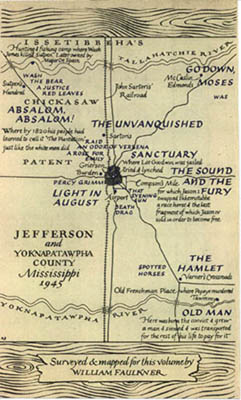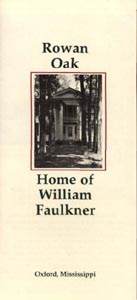
 |
Southern Roots |
William Faulkner was born on September 25, 1897, in New Albany, Mississippi, a small town thirty-five miles east of Oxford. Soon the family moved to Ripley, Mississippi, but by the time William was five, they were settled in Oxford, the county seat of Lafayette County.
This section of north central Mississippi is bordered by the Tallahatchie
River on the north and the Yocana River on the south. The county has two main
roads, both intersecting the town of Oxford, which is situated fairly close to
the middle of the region. It is an area that around 1900 was still largely
dependent on cotton, with a few plantations of moderate size. The county was full
of thickets and swamps, forest and black bottom land, and sand hills covered with
scrub pine. The railroad, begun by great-grandfather W. C. Falkner, ran south
from Tennessee, through Oxford, and on toward the Gulf of Mexico.
William Faulkner. [Map of Yoknapatawpha County] from Absalom, Absalom!(New York: Random House, 1936) and The Portable Faulkner (New York: The Viking Press, 1946). | |
| The layout of the real Lafayette County became, in Faulkner's imagination, the basic outline of Yoknapatawpha County: the same rectangular space divided by roads, rivers, and a railroad into four quadrants, divided further by diagonal secondary roads, with Oxford/Jefferson placed in the center. In the words of Malcolm Cowley, it is a mythical kingdom . . . a county in northern Mississippi, on the border between the sand hills covered with scrubby pine and the black earth of the river bottoms. Except for the storekeepers, mechanics, and professional men who live in Jefferson, the county seat, all the inhabitants are farmers or woodsmen. Except for a little lumber, their only commercial product is baled cotton for the Memphis market. A few of them live in big plantation houses, the relics of another age, and more of them in substantial wooden farmhouses; but still more of them are tenants, no better housed than slaves on good plantations before the Civil War. Faulkner drew two maps of this territory, one to accompany the first edition of Absalom, Absalom! in 1936, and the second more condensed and including the titles of his Yoknapatawpha novels in big capitals, prepared in 1946 for the Viking Portable Faulkner. Both indicate that Faulkner is the creator of the region, either the Ňsole owner and proprietorÓ or the person responsible for the surveying and mapping. Of all FaulknerŐs novels, by far the majority are concerned with Yoknapatawpha County and its people, beginning with Sartoris in 1929 and continuing throughout his career to The Reivers, published a month before his death on July 6, 1962. |
 |
 See photos of Rowan Oak |
James W. Webb. "Rowan Oak: Home of William Faulkner." University, Mississippi: University of Mississippi, [198-].This brochure is available to visitors of Rowan Oak, the house where Faulkner lived in Oxford from 1930 until his death. When he and his wife, Estelle, purchased the house and four acres of land for $6,000, there was neither electricity nor plumbing, the roof leaked, and many beams were sagging and rotting. But it was an important move for Faulkner. Located near the woods where he and his brothers had played as children, it placed him in a large, once-imposing, antebellum house, fallen into disrepair and dilapidation, very like the old plantation home of the Sartoris family and the Old Frenchman's place in Sanctuary. "The house was named by the Faulkner's for the legend of Rowan tree, which is recorded in Sir James Frazer's The Golden Bough. According to the story, Scotish peasants placed a cross of rowan wood over their thresholds to ward off evil spirits and give the occupants a place of refuge, privacy, and peace. For most of his life William Faulkner sought these qualities, and his fame caused him to seek them even more." James Web. |
The Ghosts of Rowan Oak:" William FaulknerŐs Ghost Stories for Children." Recounted by Dean Faulkner Wells. Oxford, Mississippi: Yoknapatawpha Press, 1980.By October 1930, the year the family moved into Rowan Oak, the Faulkners were ready to give a Halloween party for Cho-Cho (EstelleŐs daughter by her first marriage) and her friends. One of the "entertainments" was a story told by Mr. Bill about the beautiful Judith Shegog (whose family had built the home in 1844) and her Yankee officer, who were buried on the grounds, and whose ghost would walk from her upstairs bedroom and out to the grave on every anniversary of her death. Mr. Bill was so accomplished a storyteller that he perhaps frightened the children too much. But in any case, several listeners remember vividly the experiences of those stories, including his niece Dean Faulkner Wells. Therefore, after an interval of fifty years, she gathered into this publication some of the most fearsome of the tales, including the one about the lovely and doomed Judith. As Willie Morris says in the introduction, Mr. Bill would sit on the front steps of the dark house with the children clustered around and speak "low and rapidly so that they had to lean closer and be very quiet to catch his words . . . He meant to frighten them out of their wits, and he succeeded." |
 |